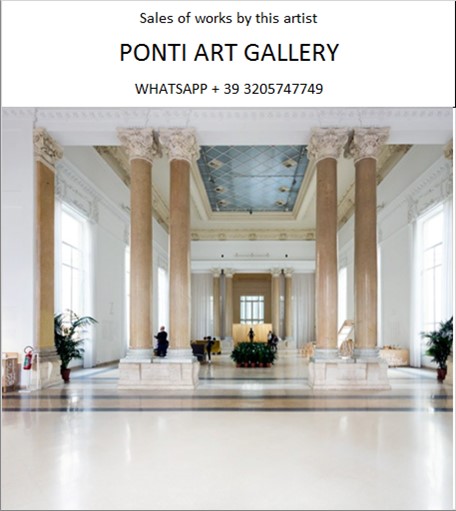Ponti Art Gallery is interested in buying and selling works
of art by this artist.

David Smith Biography
David Roland Smith, an American Abstract Expressionist sculptor and painter, was a trailblazer in the art world, best known for his large steel abstract geometric sculptures. Born on March 9, 1906, in Decatur, Indiana, Smith's early life was steeped in the industrial heartland of America, which would later profoundly influence his artistic language. His father, a telephone engineer and part-time inventor, instilled in him a reverence for machinery, while his mother, a school teacher, provided a strong educational foundation.
Smith's artistic inclinations were evident from a young age, and after moving to Paulding, Ohio, in 1921, he pursued art through a correspondence course in drawing. His formal education included a brief stint at Ohio University, followed by an even shorter time at the University of Notre Dame. The lack of art courses led him to drop out, but the summer job he took at a Studebaker automobile factory in South Bend, Indiana, was pivotal. There, he learned welding and riveting—skills that would become central to his later work as a sculptor.
In 1926, Smith moved to New York City, where he enrolled at the Art Students League. It was here that he met his future wife, Dorothy Dehner, and was exposed to the teachings of John Sloan and Jan Matulka. Through Matulka, Smith encountered the works of European modernists like Piet Mondrian, Wassily Kandinsky, and the Cubists, which had a lasting impact on his artistic development.
Smith's early works were paintings, but by the early 1930s, he began incorporating found objects into his canvases, transforming them into sculptural reliefs. This experimentation led him to sculpture, and by 1933, he had established his workshop at the Brooklyn Navy Pier. His innovative approach to sculpture involved using industrial materials and techniques, which set him apart from his contemporaries who were working with traditional methods.
During the 1930s, Smith's focus shifted predominantly to sculpture, creating welded constructions using found objects and forged metal. His move to Bolton Landing, New York, in 1940, marked a significant period in his career, where he produced many of his major works. The rural environment was essential to his evolution as an artist, influencing the size and imagery of his sculptures.
Smith's sculptures from the 1940s and 1950s displayed a personal, landscape-inspired aesthetic with a delicate linear quality, akin to drawing in metal. His works from this period echoed the aesthetics of contemporary painting and established his reputation as a leading figure in the Abstract Expressionist movement. He formed strong friendships with other avant-garde artists, including Willem de Kooning, Arshile Gorky, and John Graham, which further enriched his artistic milieu.
By the late 1950s, Smith's sculptures began to assume monumental proportions, with overlapping geometric plates of highly polished steel that developed a reductive and geometric aesthetic. These massive pieces from the 1960s are considered precursors to the minimal "primary structures" that emerged later in the decade, showcasing Smith's forward-thinking approach to sculpture.
Smith's career was tragically cut short when he died in a car accident near Bennington, Vermont, on May 23, 1965. Despite his untimely death at the age of 59, his legacy endures. Major exhibitions of his work have been presented worldwide, and his sculptures are held in the collections of prestigious institutions such as The Museum of Modern Art in New York, the Hirshhorn Museum and Sculpture Garden in Washington, D.C., and the Peggy Guggenheim Collection in Venice.
David Smith's contributions to American art are monumental. He pioneered the technique of welding in America to make art, a method that resonated with his industrial background and his deep understanding of materials. His sculptures, often executed in series, explored ideas about materials and composition, and his work evoked the figure even in its largely abstract form. Smith's oeuvre is a testament to his belief that art could be as free as the mind and as complex as life itself.
David Smith Quotes and Sales
of Works
Ponti Art Gallery selects and deals with paintings by the
artist. Upon request, we provide free estimates and
evaluations, communicate prices, quotations, and current
market values.
If you are interested in BUYING or SELLING works by the
artist, contact us immediately.
If you wish to sell or receive an evaluation of the
works:
Send us a frontal photo of the painting, one of the back,
and one of the signature. Also, indicate the dimensions of
the work. Inform us about the purchase origin of the work
and any kind of available documentation (purchase
receipts, certificates of authenticity, publications). One
of our operators will respond to you on the same day. We
guarantee maximum confidentiality and extreme
professionalism.
If you wish to purchase works by the painter: Contact us
and let us know your request. We will inform you about the
available works. We also offer the possibility to
subscribe to our NEWSLETTER, through which you will be
informed at the beginning of each month about the latest
acquisitions of the art gallery.
You can send us pictures of the work:
